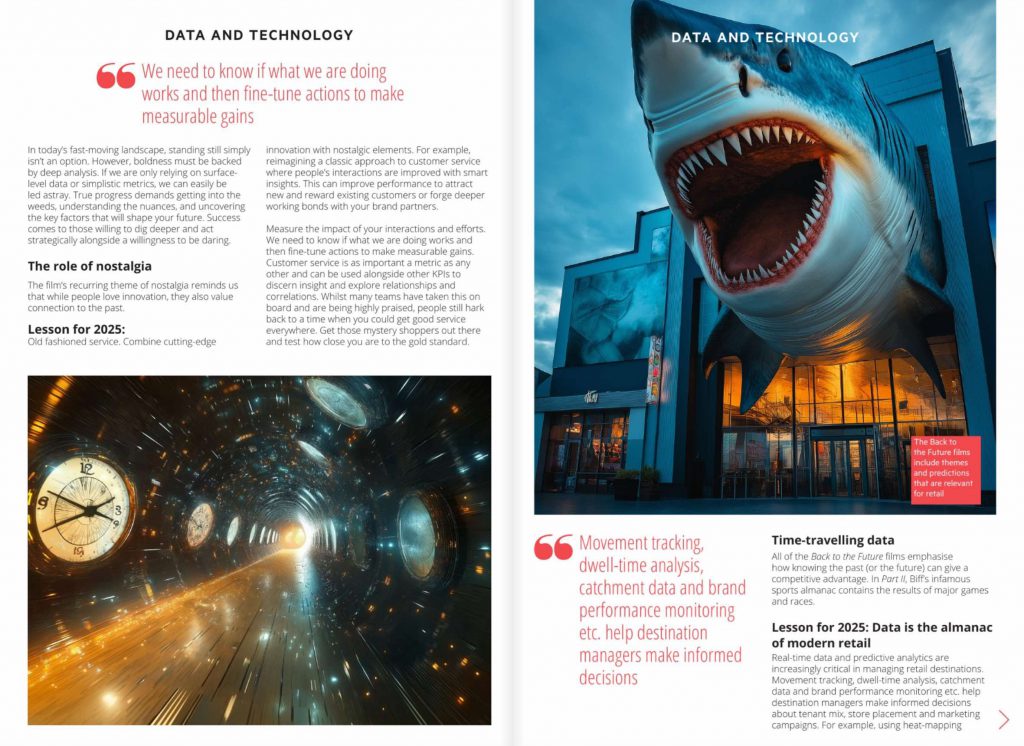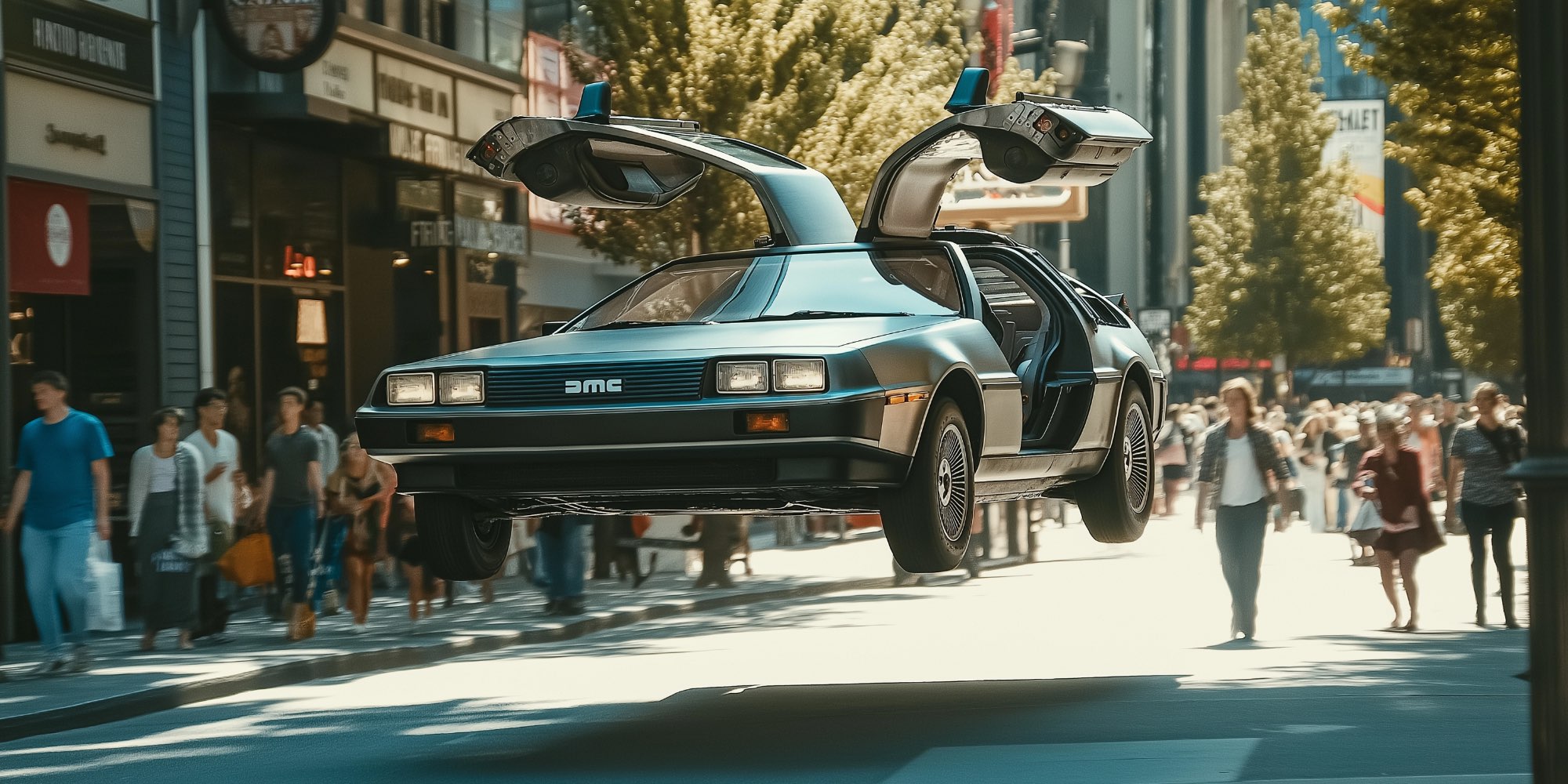As featured in Retail Destination magazine, ART’s director, Gareth Jordan, explores how we might look Back to the Future to inspire retail strategies as we head towards 2025.
This year celebrates the 35th anniversary since the release of Back to the Future Part II (the film where they go to the future), so we thought it might be fun to explore themes and predictions in this cult classic to see how close they came to reality and where they might inform real retail innovation today.
Although it was a vision of 2015 way back when the film was made in 1989, we find a mix of imagination with timeless lessons about technology, customer engagement, and adaptability. Futuristic technology often conjures visions of device-heavy retail environments and virtual interactions. Still, it is the invisible digital layer that will continue to set forward-thinking retail destinations apart in 2025.
Anticipating Consumer Expectations
In Back to the Future Part II, the future (now) includes hoverboards, electronic payments, flying cars and VR headsets. While only some of these ideas have materialised, they reflect how imagining the future can inspire genuine advances and also align with customer desires.
Lesson for 2025: Be bold
Embrace bold, forward-thinking ideas to anticipate and create demand. The world is undergoing seismic shifts, and many brands are responding with dramatic overhauls. Some are desperate gambles, while others are well-planned transformations happening quietly behind the scenes. Take Jaguar’s recent rebrand — it’s unconventional, surprising, and a bold signal that a dramatic change is coming, sparking conversations everywhere. Their approach breaks away from traditional norms, teasing a new era. What exact changes will emerge from the brand are still yet to be seen, but it is a good illustration of how bold moves can set the stage for potential future success.
In today’s fast-moving landscape, standing still simply isn’t an option. However, boldness must be backed by deep analysis. If we are only relying on surface-level data or simplistic metrics, we can easily be led astray. True progress demands getting into the weeds, understanding the nuances, and uncovering the key factors that will shape your future. Success comes to those willing to dig deeper and act strategically alongside a willingness to be daring.

The Role of Nostalgia
The film’s recurring theme of nostalgia reminds us that while people love innovation, they also value connection to the past.
Lesson for 2025: Old Fashioned Service
Combine cutting-edge innovation with nostalgic elements. For example, reimagining a classic approach to customer service where people’s interactions are improved with smart insights. This can improve performance to attract new and reward existing customers or forge deeper working bonds with your brand partners.
Measure the impact of your interactions and efforts. Much like any other area of retail, we need to know if what we are doing works and then fine-tune actions to make measurable gains. Customer service is as important a metric as any other and can be used alongside other KPIs to discern insight and explore relationships and correlations. Whilst many teams have taken this on board and are being highly praised, people still hark back to a time when you could get good service everywhere. Get those mystery shoppers out there and test how close you are to the gold standard.
Time-Traveling Data
All of the Back to the Future films emphasise how knowing the past (or the future) can give a competitive advantage. In Part II, Biff’s infamous sports almanac contains the results of major games and races.
Lesson for 2025: Data is the almanac of modern retail

Real-time data and predictive analytics are increasingly critical in managing retail destinations. Movement tracking, dwell-time analysis, catchment data and brand performance monitoring etc. help destination managers make informed decisions about tenant mix, store placement, and marketing campaigns. For example, using heat-mapping technology to identify high-traffic areas can guide strategic placement of key tenants or promotional activations, maximising engagement. Similarly, predictive analytics can inform event programming or brand selection based on customer preferences and trends.
AI forecasting is also revolutionising predictive analytics by simplifying the process and eliminating the complexities of traditional methods. With just a few clicks now, tools can give you the ability to customise your insights by applying filters and adjusting variables, tailoring forecasts to answer your unique questions. We are facilitating our clients to dive deep into the past with their historical data and emerge with predictions that empower smarter, data-driven decisions as they look to the future.
Adaptability to Change
Marty and Doc Brown constantly adapt to new challenges, illustrating the importance of agility.
Lesson for 2025: Agility
The traditional anchor-tenant model is being redefined to include a mix of shorter leases and pop-ups, digitally native retailers, and boutique offerings to create unique places and more flexibility. Retail destination managers are curating a diverse tenant mix that reflects changing consumer interests, such as fitness studios or culinary and leisure experiences. Thematic zoning informed by data insights, such as organising clusters of stores around specific themes like wellness, technology, or fashion, helps create distinct identities for spaces that can adapt with consumer shifts. It also offers points of comparison at a portfolio level for things that don’t sit within common boundaries.
Personalisation and Immersive Experiences
The film’s futuristic but nostalgically themed Café ’80s shows a blended mix of digital ordering, which is now a very familiar picture in restaurants today. However, the prediction that people living in 2015 would design 80’s themed cafés is perhaps interesting in itself, given the rise of immersive hospitality.
Lesson for 2025: Personalise and make it memorable
Not every moment can or should be a wow experience, but by leveraging technologies, you can offer customers a self-selecting experience that allows them to choose when they want to engage. Through AR, VR and AI-driven personalisation, placemakers can create unforgettable shopping destinations with the right mix of wow moments and digital and interactive experiences to suit their destinations. Whilst it is not about transforming all retail or restaurants into theme parks, some exciting immersive operators take themed shops and hospitality to new sensory levels. For example, I recently saw the founders of Ephemera Group speaking about their immersive restaurants in Paris, where spaces are customisable and include taking diners to space or under the sea.
Join us at Retail Destination Live 2025, where we will be delving further into the views of different professionals on the future of technology in retail with a panel session. The agenda shaping up promises important debate and learnings for the year ahead.

